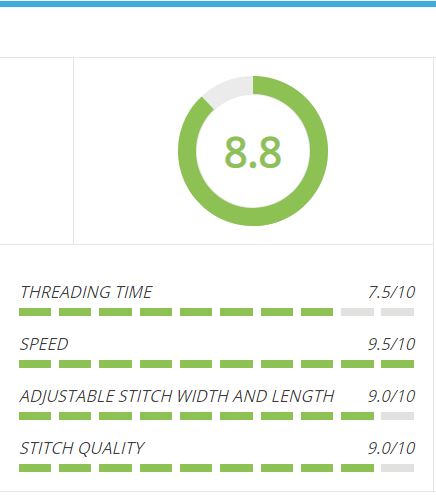Juki MCS 1500 Coverstitch and Chain Stitch Machine: Beloved by All?
Sometimes a standard hem works just fine. Sometimes it doesn’t.
That’s when you need the capabilities of a coverstitch (or chain stitch) machine like the Juki MCS 1500.
More...
When you want or need a more professional looking hem than what your basic sewing machine can give you, that’s when you should look into getting a coverstitch (also spelled as two words: cover stitch) machine.
In this Juki MCS 1500 review, I’ll look at the possibilities that this machine offers for satisfying your coverstitching needs.
Contents
Why Do I Need a Coverstitch Sewing Machine?
You have probably spotted that some of the clothing you buy at the store (or online) has multiple rows of stitching for the hems.
You may also have noticed that this type of stitching is often found on the more stretchy fabrics such as those used for sweatshirts and aerobic wear, as well as fleece, lycra, and knits.
It is a coverstitch machine that gives you a double or triple row hem on the top side of the fabric and a mesh of stitches on the back, similar to what a serger can do.
Why Should I Get the Juki 1500 Coverstitch Machine?
With this machine, you can sew coverstitch hems with up to four spools of thread - three for the top stitches and one for the looper on the back.
Size Adjustable Stitches
If you choose to use only three spools and two needles, you get to decide how wide you want the hem stitches to be.
At the narrow setting, the width is 2.5 millimeters. The wide setting is five millimeters.
You might use the narrow coverstitch for lighter weight fabrics. This option will help keep your fabric from tunneling, a nasty effect that can take a lot of time to fix.
You can change the stitch length - up to a four-millimeter maximum - for even more variation in the look of your hems.
If you accidentally sew your hem incorrectly, a coverstitch can be very easy to remove. You can pull the looping on the back so easily that it almost removes itself.
It might not sound right at first. Don’t worry, though! You can just as quickly tie this off so that it won’t free itself when you don’t want it to.
Click to see its Amazon's price.
Chain Stitch
When you use just one needle (two spools of thread) in your Juki MCS-1500, you create a chain stitch. This is actually a kind of decorative embroidery that you can use anywhere on your fabric - not just at the edge.
Since you can work a chain stitch wherever you like, the Juki gives you seam guidelines on the extension plate.
You can also use a chain stitch for such mundane things as sealing bags or as a “safety” stitch on projects that you might need to take apart sooner or later.
The chain stitch is also great for doing gatherings.
Presser foot clearance
A thoughtful feature the Juki provides is that the tip of the presser foot is higher than the back so you can easily insert your fabric underneath it.
You can also raise the foot 8 to 10 millimeters in case you have thicker fabric that needs that extra space.
Thread cutter
No one likes the hassle of finding a pair of scissors and cutting the thread once the sewing is done. To counter this, it has an external thread cutter on the front above the presser foot.
Its sharpness helps ensure consistent and smooth cutting of thread without the need for a pair of scissors.
Speed
The maximum speed of this machine is 1350 stitches per minute, which is quite fast for a consumer-grade model.
Footprint and weight
If you’re concerned about how much of your sewing area this machine will take up, you probably need not be.
It's lightweight at around 7 KG, and the footprint is just 11.0236" (length) by 13.18898" (width) by 11.2205" (height).
So while this probably isn’t the only machine you will own, you likely will have room for this additional machine.
Click to see its Amazon's Price.
Is It Difficult to Use This Machine?
Probably the most difficult part of using this coverstitch machine is threading it, especially if you are going to employ all four spools for three stitches on top plus the looper in back.
Juki does all it can to help you with this by providing detailed diagrams in the owner’s manual, by color coding the thread paths on the machine, and by recording handy videos online.
If you look closely at the machine, you can see purple guides for the looper thread, blue for the right needle, green for the center, and yellow for the left.
Even with the diagrams and the color coding, it’s still quite an involved process. Thankfully Juki makes an excellent video that leads you through the procedure step by step.
Verdict
Other than the threading process being a bit complicated, there is virtually nothing negative to say about the Juki MCS 1500.
It’s hard to find anyone else who would disagree with this assessment.
The MCS 1500 truly is loved by virtually everyone who uses it.
It appears that the Bernina L220 may be the same machine with different branding. So if you come across one of these, the same comments from this review should apply to it as well.
Click to see its Amazon's Price.
Related readings:
Here is the article that talks about the best coverstitch machines for 2024.
You might also like the comparison between the coverpro 900cpx and 1000cpx.

PROS
- Portable
- High presser foot lift for thick fabrics
- Adjustable differential feed
- No skipped stitches
CONS
- Although threading needs some practice, it's easy to learn.

